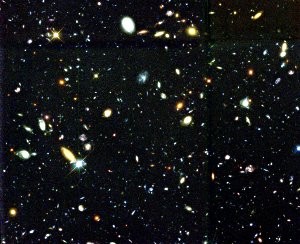One of the main building blocks of our understanding of the history of the universe is a theory called inflation. In inflation, the very young universe experienced a sort of explosion, causing it to grow so fast that light itself couldn't keep up. Because it happened so fast, we can't measure how much space grew during inflation, leading us to points #2 and #3.
Points #2 and #3 are impossible to answer because we rely on light to carry information to us from the far reaches of space, and light can only travel at the snail's pace of 186,000 miles in a second. This is all fine and dandy when making a call on your cell phone, but observing the far reaches of the universe can become a real test of one's patience. If I were to chat with an alien from the nearest star, I'd have to endure a pause of several years for a response after every question. If I want to know what's happening in some of the most distant galaxies, I have to wait BILLIONS of years.
Research has shown that the universe is about 14 billion years old. Going back nearly this far, we see the oldest photons in the universe, from the cosmic microwave background. If I were to half-heartedly attempt to answer Tarons question, I would simply say that this background is the edge of the OBSERVABLE universe and call it a day.
This over-simplification misses the mark in several ways. First, the info we get from the cosmic microwave background is a bit outdated, to say the least. It tells us about the universe as it was 14 billion years ago, and things have changed quite a bit in that time. The spots in the cosmic microwave background have since receded from us even further and have evolved into stars and galaxies in that time. If we were able to measure the distance to those stars and galaxies now, without the inconvenience of the speed of light, we'd measure a distance of 46.5 billion light years.
The second way in which this over-simplification is unsatisfactory is that it ignores all that lies beyond the observable universe. We know from inflation that the universe is much larger than what can be observed, but we have no idea of how much larger. In fact, it is probably impossible to ever know what lies beyond the observable universe since we cannot retrieve any information from those far reaches of space.
Finally, using the distance from Earth to the cosmic microwave background almost implies that we are at the center of the universe. In reality, the cosmic microwave background will appear equally distant when observed from all points in space, and everyone will appear to be at the center of a universe 14 billion years old. Each point in space is just a different reference frame, each having its own visible region of the cosmic microwave background and its own visible population of galaxies.
To be honest, because of these complications, I don't even bother thinking about the size of the universe. Instead, I think in an easily measured quantity called redshift. The way I see it, the fact that we are limited to a single reference frame and the finite speed of light is part of a game. To ask what lies beyond this set of rules is to open the whole philosophical can of worms that is metaphysics, and I'm not the one to do that.
 Kyle S. Dawson is engaged in post-doctorate studies of distant supernovae and development of a proposed space-based telescope at Lawrence Berkeley National Laboratory.
Kyle S. Dawson is engaged in post-doctorate studies of distant supernovae and development of a proposed space-based telescope at Lawrence Berkeley National Laboratory.
 The Hubble Deep Field: The galaxies in this image
The Hubble Deep Field: The galaxies in this image